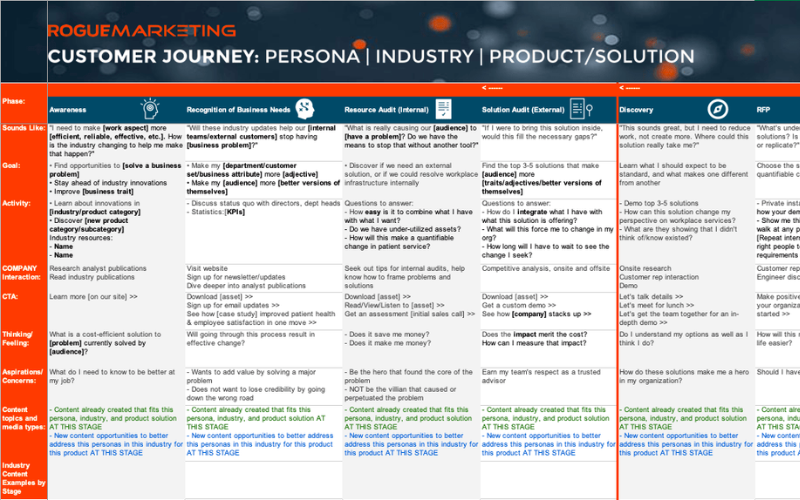B2B Content Marketing: How to Start Quickly
Too many brands get hung up on their audience type: B2B, P2P, B2C, etc. Every brand helps a single person resolve a specific problem by providing a...
4 min read
![]() Rogue Marketing
Jan 10, 2019 1:00:29 AM
Rogue Marketing
Jan 10, 2019 1:00:29 AM
When everything is important, how do you truly prioritize the things that deserve time, attention, and budget?

* Need to prioritize marketing initiatives
* Want to get ahead of one-off requests that become fires
* Have a project that needs budget approval
How many of these did you hear—or say—in the last 12 months?
Taken by themselves, these concerns aren’t “wrong.” But they are out of context. That’s often (but not always) true when you hear these and other phrases around the conference room table.
You just might have a social media problem. But there is no shopping cart feature on Facebook (yet), so counting revenue from social media is not a direct measurement. Even with UTM tracking or gift code usage, you’re always going to have some drop-off.
You might have a site issue; or, your ad targeting is improving, so you have fewer low-value visitors. Your copy updates may also be doing a better job of getting people to fill out the form sooner, and so visitor time on site is down.
“Context is the difference between a concern and an issue.”
Before you begin to put together marketing plans, you need a consensus on the key problems you are trying to solve. That way you can work through the marketing mix you need to make the right impact on your business. Here are the questions you will need in order to lead an effective consulting session with your team:
When you look back on today, 12 months from now, what result do you need to show?
The answer to this one is most often a form of revenue: “We need to have increased sales by 20%.”
Great. Why is that the “right” goal?
The goal may be entirely out of your hands: “Our venture capital owners are dictating that number.” But your answer may be based on any number of potential factors: “Our material costs are getting taxed at a  higher rate.” “Our operating costs are too high and we need to offset them with revenue.” “We’re preparing to sell the company and need to demonstrate growth.”
higher rate.” “Our operating costs are too high and we need to offset them with revenue.” “We’re preparing to sell the company and need to demonstrate growth.”
The truth is, the solutions are as complex as the problems, so this blog post won’t make an overly simplified attempt to solve them. For example, every sale you make requires operating costs, so increasing sales also increases the problem more than it provides a solution.
In other words, what may sound like a marketing problem (“increase leads so that sales can sell more stuff”) is actually a business problem. The marketing team then may need to focus on lowering the cost of acquisition or increasing the conversion rate rather than increasing lead generation volume. And that’s just scratching the surface.
You probably want a team in your corner that understands the nuance and can prepare you to succeed where others have failed.
What is your biggest obstacle to reaching that goal?
This is where most concerns start—with the “thing” that appears to be an obstacle. The answers you may hear in a leadership meeting may sound like, “We need better paid media.” “Our social media needs to step it up.” “Our website is outdated. We need to redesign it and have a more consistent message.”
Chances are, they’re all right. Every concern that comes up around the table was brought up because it has been a thorn in someone’s side. That’s why your next question has to be a harsh filter:
If you make that change and overcome that obstacle, will it directly impact your goal?
At first, their heads nod. It sounds like you’re just flipping the equation on them…and you are. But then you start to scrutinize each one:
“Our website is outdated.” So if you change the images, layout, and forms on your site, you will get more revenue? This is where someone tends to speak up and say, “Well…they aren’t filling out the forms on our site like they used to.” Now you’re having a user experience conversation, not a conversation about blue versus green, or illustrations versus lifestyle imagery.
This section of the conversation can last hours (OK, it can last a lot longer than that). These challenges deserve to be sussed out, but you also need to manage the time so that people don’t just leave the room frustrated. Some people may have the task to find data to make sure everyone lands on an informed decision. In business, there’s a time for egos…this is not one of them.
So, someone has gone through the entire process, from awareness to decision, and they have decided they want to work with you, buy from you, and trust you: At this point, what is STOPPING that transaction?
You may find that there are not a significant number of answers to this question. In fact, you may find that there’s not even much arguing. This question will either help to clarify which of the previous items is the right one…or it will show what was missed that should have been identified in the first place.
 You won’t want to start with this question, though it may sound absurd. All of the previous questions help each person’s mind work through the organization’s problems, from his or her own perspective, so that when they have cleared their favorite obstacle in their own mind, it’s no longer in their own way of seeing this final solution. If you start here, then the answer will be one of the items you’ve discussed earlier, or they may say, “Nothing.” That’s where you will miss this insight.
You won’t want to start with this question, though it may sound absurd. All of the previous questions help each person’s mind work through the organization’s problems, from his or her own perspective, so that when they have cleared their favorite obstacle in their own mind, it’s no longer in their own way of seeing this final solution. If you start here, then the answer will be one of the items you’ve discussed earlier, or they may say, “Nothing.” That’s where you will miss this insight.
When you have walked through this process, perhaps on your own or with a small team, or with an executive team, you build the goals you need to reach, and identify the KPIs you need to hit. Everything else becomes secondary to those answers.
Everyone wants a piece of the marketing department’s time. And the marketing leader faces enormous pressure to perform, not just on the priorities they see… but also on the priorities that other executives may be holding for them. As the marketing leader, you can gain consensus—and authority—when you can demonstrate the goal you’re reaching for and your path to get there.
%20(7).png)
Too many brands get hung up on their audience type: B2B, P2P, B2C, etc. Every brand helps a single person resolve a specific problem by providing a...

TL;DR: If you’re an executive with a team, this 2,200-word article will help you think through strategies to improve lead attribution. Skip to the...

Understanding the customer journey for each of your key personas is definitely the right next step. But how do you create a customer journey map that...